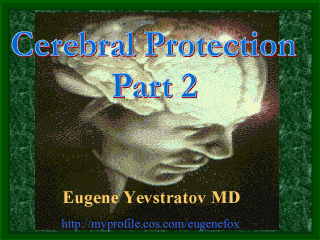 Cerebral
Protection. Part I |
The increased understanding of
the pathogenesis of ischemic neuronal damege has opened new approaches in research for
improving protective methods through the addition of appropriate pharmacological
agents.The failure of neurotrasmitter transport is an essential step in the pathogenesis
of ischemic cerebral injury. Ater release into the intercellular space, glutamate is taken
up into glial cells and rapidly converted to glutamine after which it reenters the neuron
ready to be used for the next message. Under conditions of hypoxia or ischemia, the
conversion of glutamate to glutamine is interrupted. This leads to its accumulatioon in
the intercellular space, where glutamate acts as a neurotoxic substance. Here its opens
calcium channels, leading to an influx of calcium, which then initiates the catastrophic
intracellular cascade leding to neuronal apoptosis and cell death. (Lipton and
Rosenberg 1995). |
